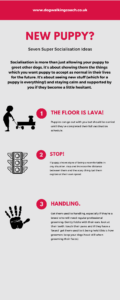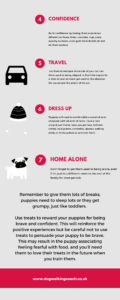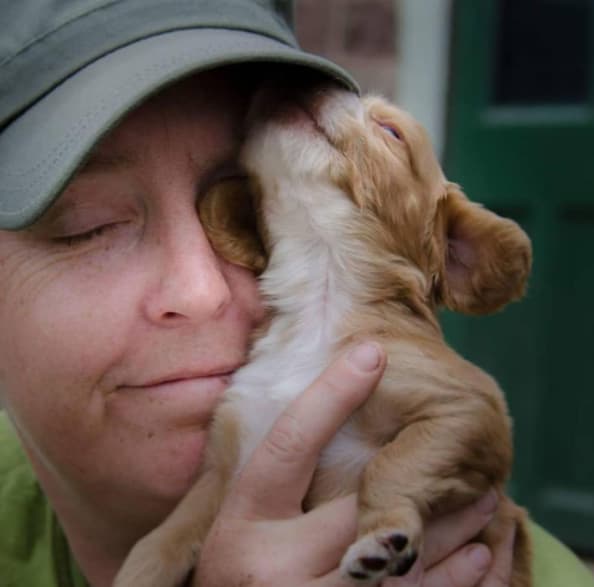In most circumstances, a puppy will be able to go with their dog walker from around 6 to 8 months old depending on the type of walk offered and the breed of the dog.
As a dog walker, our first concern should be for the dogs in our care. Owners will often ask what age can a puppy go with a dog walker? Taking puppies out too young, walking too far or too long for their age, or taking them to unsuitable locations holds the possibility of harming a puppy both physically and behaviorally.
Before puppies reach full size they have soft growth plates between their joints and the growth of these is affected by the hormones in their bodies. If you yourself have had new puppies in the last few years you may have discovered that vets are reluctant to neuter quite as young as they used to and this is why. When they remove the hormones by neutering, the growth is affected resulting in higher rates of dysplasia and joint issues.
These soft growth plates can also be damaged by over-exercising or enthusiastic exercising involving lots of jumping and landing or climbing. The advice these days is to even be careful to reduce puppies going up and down stairs to protect their joints, so imagine how a mountain hike might affect them.
The standard advice has been to exercise puppies no longer than 5 minutes per month of age until fully grown. This leaves a 6 month old dog having no longer than a 30-minute session. The breed matters too because smaller dogs will reach their full growth sooner than larger dogs, plus, there are some dogs more susceptible to joint issues such as Labradors.
However, we know that different walkers offer different types of walk, or you may have a better group for the puppy to go with initially. One group might be an enthusiastic hour in a forest, whereas your second group of the day might be a more sedate, flat, grassy park plod. (Read more about how to group your dogs here)
This is where we apply our experience and expertise and advise the owner accordingly.
If you’re able to fit it into your day, I feel that the following is an ideal puppy offering, starting at 8 weeks and moving through to adulthood.
Pop ins
You start by offering puppy pop ins into their home, usually 10 to 20 minutes to feed, clean up and let the puppy out for a wee break. Fitting these in before and after your group walks normally gives fairly good timings for the puppy being around 10:30 and 3 pm ish.
As the pup grows older it’s a great opportunity to introduce them to your vehicle and where they’ll be sitting when travelling to and from walks. Some owners choose not to crate train so this might be the first time they’ve even seen one. Introduce them gently and let them explore at their own speed.
Solo walk
From 14 weeks once all the vaccinations are complete the puppy is walked solo and your pop-ins increase to 30 minutes. To start with you’ll still be cleaning up and doing a short walk, just to get them used to walking with you on a lead.
As they get older, the cleaning reduces and the walk time can increase so that you can incorporate some recall training. I would suggest keeping these walks from the owner’s front door to save travel time on your day (and fuel!)
Puppies are in a really important socialisation stage up until around the 16-week mark where it’s really important to show them as much as possible in a positive manner. So getting them used to you, your vehicle and walking with you will benefit you both as they get older.


Group walks
Owners will be keen to get their puppy on group walks asap. It’s often simpler to manage the puppy’s activity level during an hour’s walk than to explain to the owner about growth plates and hormones. I would still try and delay this stage as long as you can to protect their growing joints. I’d be happier taking a 6 month old pup out than a 5 month old.
Try and have them join your most sedate and calm group walk with adult dogs who can act as role models for the puppy. Dogs can and do learn from each other and you’re going to have your hands full with the puppy so having the rest of the group as well balanced polite dogs will help you out.
Popping the puppy on a shorter lead, doing a bit more sniffing, sitting down for a play on the grass with everyone, and even carrying them if they’re small, can all be ways to manage their activity level.
What age can a puppy go with a dog walker?
Once the puppy is fully grown (younger for smaller breeds, older for larger ones) then they can join a higher energy group if you feel that’s a better fit for them.
AFFILIATE DISCLAIMER
The dog walking coach website is supported by our visitors. Some of the product links on this website are through affiliate schemes such as Amazon. This means that I earn a small commission if you choose to purchase something at no extra cost to yourself.
